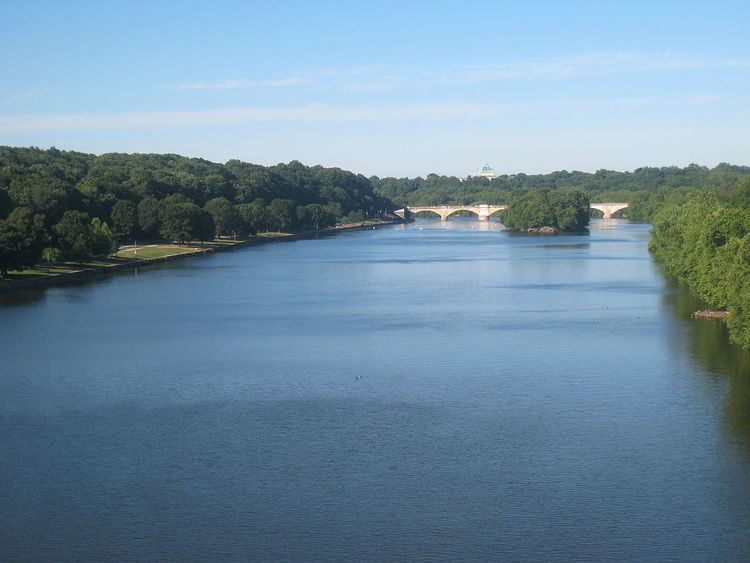NRHP Reference # 72001151 Year built 1812 Added to NRHP 7 February 1972 | Area 37.23 km² Phone +1 215-683-3600 | |
 | ||
Location Both banks of Schuylkill River and Wissahickon Creek, from Spring Garden St. to Northwestern Ave. in Philadelphia Architectural style Colonial Revival, Georgian, Federal Address Philadelphia, PA 19119, USA | ||
Fairmount park philadelphia skyline
Fairmount Park is the largest municipal park in Philadelphia, Pennsylvania and the historic name for a group of parks located throughout the city. Fairmount Park consists of two park sections named East Park and West Park, divided by the Schuylkill River, with the two sections together totalling 2,052 acres (830 ha). Management of Fairmount Park and the entire citywide park system is overseen by Philadelphia Parks & Recreation, a city department created in 2010 from the merger of the Fairmount Park Commission and the Department of Recreation.
Contents
- Fairmount park philadelphia skyline
- Fairmount park philadelphia
- History
- Growth
- Properties
- Public art
- Historic houses
- References
Many other city parks had also been historically included in the Fairmount Park system prior to 2010, including Wissahickon Valley Park in Northwest Philadelphia, Pennypack Park in Northeast Philadelphia, Cobbs Creek Park in West Philadelphia, Franklin Delano Roosevelt Park in South Philadelphia and 58 additional parks, parkways, plazas, squares and public golf courses spread throughout the city. Since the 2010 merger, however, the term "Fairmount Park system" is no longer used by the Parks & Recreation department, and the adjacent Wissahickon Valley Park and all other park areas are considered completely separate entities.
Fairmount park philadelphia
History
Fairmount Park, Philadelphia's first park, occupies 2,052 acres (830 ha) adjacent to the banks of the Schuylkill River. Since 2010, Philadelphia Parks & Recreation divides the original park into East and West Fairmount parks. The original domain of Fairmount Park consisted of three areas: "South Park" or the South Garden immediately below the Fairmount Water Works extending to the Callowhill Street Bridge; "Old Park," which encompassed the former estates of Lemon Hill and Sedgeley; and West Park, the area including the Philadelphia Zoo and the Centennial Exposition grounds. The South Garden predated the establishment of the Park Commission in 1867, while Lemon Hill and Sedgeley were added in 1855–56. After the Civil War, work progressed on acquiring and laying out West Park. In the 1870s, the Fairmount Park Commission expropriated properties along the Wissahickon Creek to extend Fairmount Park. The Schuylkill River Trail is a modern paved multi-use trail by Kelly Drive in the East Park.
Growth
The park grew out of the Lemon Hill estate of Henry Pratt, whose land was originally owned by Robert Morris, signer of the Declaration of Independence. Purchased by the city in 1844, the estate was dedicated to the public by city council's ordinance on September 15, 1855. A series of state and local legislative acts over the next three years increased the holdings of the city. In 1858, the city held a design competition to re-landscape Lemon Hill and Sedgeley for public use as the best way to better protect the city's water supply.
As the site of the 1876 Centennial Exposition and the first zoo in the United States, the Philadelphia Zoo, Fairmount Park was placed on the National Register of Historic Places (NRHP) on February 7, 1972. The adjacent Wissahickon Valley Park, located to the immediate northwest, was also included in the Fairmount Park NRHP registration document.
Properties
Park properties include the Centennial Arboretum, a Horticulture Center, Fairmount Water Works, Memorial Hall (home of the Please Touch Museum), Shofuso Japanese House and Garden, Boathouse Row, Smith Memorial Playground and Playhouse, recreation centers, reservoirs, statues and other pieces of art.
Public art
Fairmount Park is home to a large collection of public art, largely due to the efforts of the Association for Public Art (formerly the Fairmount Park Art Association), a non-profit organization founded in 1872 to embellish Fairmount Park with outdoor sculpture, including the Florentine Lions installed in 1887. The Art Association continues to commission and care for a large number of sculptures, in coordination with the park and city. In 2007, the Art Association installed Iroquois by Mark di Suvero near the Philadelphia Museum of Art on the Benjamin Franklin Parkway.
Historic houses
Mount Pleasant, built in 1761 in what was then the countryside outside of the city by a privateer, is administered by the Philadelphia Museum of Art in Fairmount Park. The Art Museum also administers Cedar Grove, a house completed in 1750 in the Frankford neighborhood of the city and relocated to the park in 1926–1928.
Other houses in the park include Belmont Mansion (1745), Randolph House (1750), The Cliffs (1753; ruins since a fire in 1986), Woodford (1756), Hatfield House (1760), Laurel Hill Mansion (1767), Strawberry Mansion (1789), Sweetbriar (1797), Ormiston Mansion (1798), Lemon Hill (1800), and Chamounix Mansion (1802). Sedgeley, a house built in 1799 on Lemon Hill, was abandoned and later demolished after being acquired through eminent domain by the city in 1857. The Sedgeley property also included a tenant's cottage (Porter House) constructed of stone which still exists.
